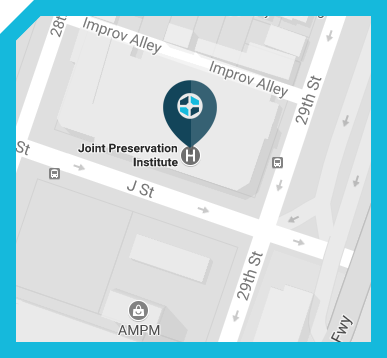
Although hip replacement is major surgery, it is also one of the most routine surgical procedures performed in the U.S. According to the Agency for Healthcare Research and Quality, more than 300,000 Americans received artificial hips last year, giving them new freedom to enjoy both the simple activities of life and the great adventures they have planned for their golden years.
The surgery has a long history, too, having first been performed over 50 years ago. Dr. Amir Jamali of Joint Preservation Institute had the honor of training under the most celebrated hip replacement surgeon in the United States, Dr. William Harris, in Boston, Massachusetts. Having performed more than 1,500 hip replacements, he has the experience necessary help you decide whether it is time to consider hip replacement. For most patients, the necessity of the procedure becomes obvious as there is a dramatic increase in their pain along with limitation of movement.
Wear and Tear
Most hip replacement patients are over 50, but the surgery may also be recommended for younger patients who suffer from severe forms of arthritis. There are many causes of hip osteoarthritis, including hip impingement, rheumatoid arthritis and post-traumatic arthritis. All of these can also lead to loss of movement.
As we age, the cartilage which cushions our joints is gradually worn away by years of friction. When the cartilage thins, bones of the hip socket and femoral head come into direct contact and we begin to experience pain and stiffness. This is the “bone on bone” situation. Arthritis symptoms can be temporarily addressed by various conservative approaches, such as exercise, medications and cortisone injections.
Many patients make the decision to undergo hip replacement when pain is constant throughout the day, even while at rest. Sufferers may notice a reduced ability to bend over or extend a leg. Running becomes impossible, and even walking is difficult. Some decide to rely on walkers or canes for a while, but this lifestyle-limiting choice is not an appealing alternative for many patients.
At this point, there is no way to regenerate the cartilage that has been lost over time. We are working on ways to transplant cartilage in our laboratory. A new artificial prosthetic hip may be the best solution. Hip replacements can last for many decades in spite of the myth that they have to be redone every 10 years.
Making the Choice
When you feel the time is right for a permanent solution to your pain, discuss your options with family members and your primary care doctor or call our office directly to schedule a consultation with Dr. Jamali. At this point, you have a wide range of choices. You may want to start with physical therapy, changes in your daily routine or pain-relieving medications. Dr. Jamali will focus not just on the surgery, but also the post-surgery recovery.
Hip replacement has been called the “Surgery of the Century,” since there is almost no other procedure that can have as large an impact on your quality of life. Your new hip will restore movement and freedom to your life, but it will never be the same as the original “native” hip. Physical activities such as running or jumping are not advised with an artificial hip. Just like driving your car for 10 weeks straight will lead to your tires wearing out and a much shorter lifespan for the car, the mechanical hip replacement can suffer the same fate if overused. Lower-impact activities such as a brisk walk, a round of golf, swimming at the pool or biking are recommended to keep your artificial hip performing for many decades. Staying healthy, building muscle strength, and keeping your weight within normal limits are other great ways to ensure your hip replacement lasts many pain-free years.
For more information on hip replacement, please request an appointment with Dr. Amir Jamali. Call or email Joint Preservation Institute today to schedule your visit to our Sacramento or Walnut Creek office.




 When Is Hip Replacement Necessary?
When Is Hip Replacement Necessary? 








